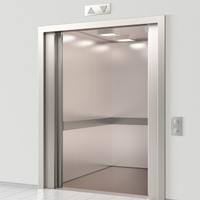Workplace Elevator and Escalator Safety Tips
June 8, 2018 Sometimes it is hard to remember just how dangerous elevators and escalators can be. According to the Centers for Disease Control and Prevention (CDC), these machines cause 30 fatalities and approximately 17,000 injuries every year. Because individuals who work near or around elevators and escalators face increased dangers, it is particularly important that employers and supervisors take the necessary steps to protect them against preventable fatal and non-fatal injuries.
Sometimes it is hard to remember just how dangerous elevators and escalators can be. According to the Centers for Disease Control and Prevention (CDC), these machines cause 30 fatalities and approximately 17,000 injuries every year. Because individuals who work near or around elevators and escalators face increased dangers, it is particularly important that employers and supervisors take the necessary steps to protect them against preventable fatal and non-fatal injuries.
The Occupational Safety and Health Administration (OSHA) defines elevators as “permanent hoisting and lowering mechanism[s] with a car or platform moving vertically”, whereas escalators are “power-driven and continuous moving stairway[s]”. Although the two modes of transportation are constructed and function differently, they pose similar risks to workers.
Who is at Risk?
The Bureau of Labor Statistics (BLS) reports that most elevator and escalator-related fatalities in the workplace are related to falls down elevator shafts, material collapses, and getting struck by or caught in between moving machine parts. One of the most effective ways employers can inhibit catastrophic injuries is by maintaining comprehensive health and safety programs, as well as remaining compliant with federal safety standards.
People working on or around escalators and elevators make up nearly one-half of the annual fatalities that occur. Some especially at-risk job positions include:
- Elevator and escalator repair people and:
- Individuals who install and/or maintain elevators and escalators
Although people who work on or near escalators and elevators are at higher risk for injury and death, anyone who uses them should be cautious and observe safety guidelines to avoid injuries. Employers are legally responsible for complying with OSHA guidelines and for maintaining safe and reliable machinery.
Elevator and Escalator Safety for Workers
The Elevator Escalator Safety Foundation (EESF) organizes awareness campaigns and safety pledges to make sure people know what the real dangers are and what steps to take to avoid them. The foundation offers some general do’s and don’ts that can lower a person’s chances for irreversible injuries.
Do:
- Always watch your step, especially when getting on or off an elevator or escalator;
- Use handrails if they are available;
- Stand away from the door inside an elevator;
- Do not try to pull open elevator doors if it is stuck; it is safer to stay inside an unmoving elevator than it is to try and get out, and:
- Use the alarm or emergency contact button to get assistance
Don’t:
- Do not use elevators or escalators if there is a fire – always take the stairs;
- Do not engage in horseplay, and:
- Do not get on crowded elevators. If an elevator is packed, wait for the next one – and be sure to observe posted weight limits
Steps Employers Should Take
Because elevators and escalators can be especially hazardous for workers, employers must maintain certain standards. Some examples of these include:
- Implement lockout/tagout procedures (or ones that de-energize electrical circuits and moving parts) during repairs or when elevators are out of service;
- Provide in-depth safety training to all employees;
- Install fall protection equipment and provide personal protective equipment (PPE) to workers, and:
- Perform routine inspections and maintenance
What if an Elevator or Escalator is Defective?
Just like other product manufacturers, companies that manufacture elevators and escalators are legally responsible for products that are safe for consumers to use. The Consumer Product Safety Commission (CPSC) oversees product safety in order to ensure that companies abide by federal guidelines. Some common dangers that can be associated with defective elevators, escalators and moving walks include:
- Serious fall hazards and:
- Impact hazards
Injuries from elevators and escalators may not be too common but when they do happen, they can be permanently disabling or deadly. If you have any additional questions about injuries related to defective escalators or elevators or that were the result of safety failures in the workplace, please contact a representative at our firm directly.
Philadelphia Products Liability Lawyers at Galfand Berger, LLP Represent Individuals Injured by Defective Products
If you were injured on a defective escalator or elevator, please contact our Philadelphia products liability lawyers at Galfand Berger. With offices located in Philadelphia, Bethlehem, Lancaster, and Reading we serve clients throughout Pennsylvania and New Jersey. To schedule a consultation, call us at 800-222-8792 or complete our online contact form.
 Google Screened
Google Screened
